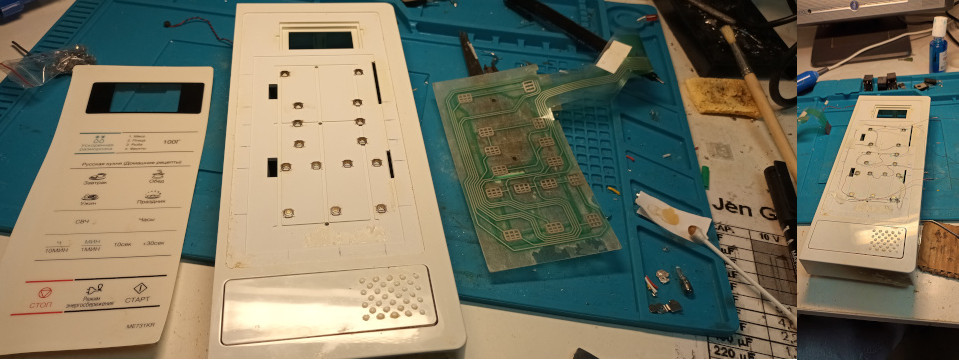Electronics tech notes, part V: assembly of automation for pressure gauge and handmade replacement of the touch panel
Executive summary
Passed three weeks I have been working on repairing electronics of
household appliances. I repaired 14 items which generated ~28000
rubles for a business and saved ~110 000 rubles for our clients.
This publication covers work on two interesting cases - custom assembly
of automation for pressure gauge and replacement of the touch panel
for microwave oven.
Cases
Automation for pressure gauge

A client had a request to build automation for his compressor instead of old one. He brought us his own components: forty years old soviet russian pressure gauge, two relays and several wires.
The circuit scheme is partly available on the photo above.
The arrow in the gauge is moved by a gas pressure in the reservoir. When it reaches a minimal pressure, it gives a first signal by breaking a current flow in the one of three wires. When it reaches the maximum pressure, it breaks the current flow in the second wire. At this stage there is no more current in the circuit and connected engine which work increases the gas pressure stops working. When decreasing pressure moves arrow to the minimal state, circuit becomes connected again, current start flow and new cycle begins.
This automation could be implemented by two relays -- by one relay on minimal and maximum pressure state. Pressure state in the circuit could be either shorted or disconnected, so two states for each position means four different states in total should implemented in the circuit. Relays perfectly fit this aim, because they could be either in the state of providing current or disabling current flow with several pins to represent its state for peripherals.
The wire which represent minimal gas indicator should be connected with a pin which represent 1st relay power supply. Pins which are shorted when power is supplied should be connected with a contactor which does or does not provide current to the pressure engine depends on current on its inductive coil.
The wire which represents maximum gas indicator should goes to a power supply pin of the 2nd relay. A wire from a pin which is shorted under power supply presence should be connected with a contactor's inductive coil.
In such configuration between minimal and maximum gas states a circuit is disconnected, therefore there is no power supply provided to the engine. To mitigate this issue contactor is shunted by providing connection from 2nd relay pin which is shorted when there is no power supplied to the relay.
There is no electronics, just electrics, but I think it might be interested for my clients and readers, because some software engineering work requires to build special apparats which is later programmed.
Handmade replacement of the touch panel
A client complained the microwave oven stops to respond on press
of touch panel.
Further investigation shown a cable to the board had some broken
contacts due erosion and oxidation. Soldering would not help
here, because this contacts are made by spraying metal
particles to the silicone surface. Usually you have to buy a
new cable for replacement, but this days you could not find it
on the market.
Handmade replacement of the touch panel is the next option.
Small buttons were used to replace the touch panel and glued to
the board. The next step was tediously soldering small wires
taken from a transformer (they are varnished for insulation) to
each button and interconnected with each other according to a
circuit reverse engineered from the original cable. The end
parts of this wires were soldering directly to the main board.

After assembling it back test launches shown it works well and the microwave became ready to be sent back to the client. A few related publications:
Electronics tech notes, part IV: repairing sound amplifier and TV
Electronics tech notes, part II: recover a manufactory machine
Electronics tech notes, part I: repair a power supply